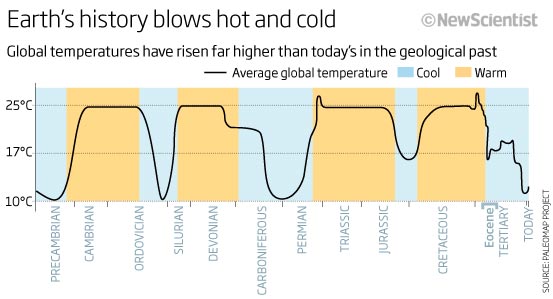Environment & Energy
Related: About this forumStudy Worst Case: 1/3 Of Humans Will Face Heat Matching/Exceeding The Sahara w/i 50 Years
Last edited Tue May 5, 2020, 08:51 AM - Edit history (1)
The human cost of the climate crisis will hit harder, wider and sooner than previously believed, according to a study that shows a billion people will either be displaced or forced to endure insufferable heat for every additional 1C rise in the global temperature.
In a worst-case scenario of accelerating emissions, areas currently home to a third of the world’s population will be as hot as the hottest parts of the Sahara within 50 years, the paper warns. Even in the most optimistic outlook, 1.2 billion people will fall outside the comfortable “climate niche” in which humans have thrived for at least 6,000 years.
The authors of the study said they were “floored” and “blown away” by the findings because they had not expected our species to be so vulnerable. “The numbers are flabbergasting. I literally did a double take when I first saw them, ” Tim Lenton, of Exeter University, said. “I’ve previously studied climate tipping points, which are usually considered apocalyptic. But this hit home harder. This puts the threat in very human terms.”
EDIT
At that level, about 30% of the world’s population would live in extreme heat – defined as an average temperature of 29C (84F). These conditions are extremely rare outside the most scorched parts of the Sahara, but with global heating of 3C they are projected to envelop 1.2 billion people in India, 485 million in Nigeria and more than 100 million in each of Pakistan, Indonesia and Sudan.
EDIT
https://www.theguardian.com/environment/2020/may/05/one-billion-people-will-live-in-insufferable-heat-within-50-years-study
progree
(10,901 posts)The title is: "One billion people will live in insufferable heat within 50 years – study"
also couldn't find "30" or "thirty", i.e. anything saying what might happen 30 years from now, which would be 2050.
hatrack
(59,583 posts)As the climate continues to warm over the next half-century, up to one-third of the world’s population is likely to live in areas that are considered unsuitably hot for humans, scientists said Monday. Currently fewer than 25 million people live in the world’s hottest areas, which are mostly in the Sahara region in Africa with mean annual temperatures above about 84 degrees Fahrenheit, or 29 Celsius. But the researchers said that by 2070 such extreme heat could encompass a much larger part of Africa, as well as parts of India, the Middle East, South America, Southeast Asia and Australia.
With the global population projected to rise to about 10 billion by 2070, that means as many as 3.5 billion people could inhabit those areas. Some of them could migrate to cooler areas, but that would bring economic and societal disruption with it.
The parts of the world that could become unsuitably hot “are precisely the areas that are growing the fastest,” said Timothy A. Kohler, an archaeologist at the University of Washington and an author of the study, which was published in Proceedings of the National Academy of Sciences.
The 3.5 billion figure is far higher than most estimates of the global population that will face the most dire impacts of climate change. A 2018 World Bank study, for example, estimated that climate change would force about 140 million people in Africa, South Asia and Central and South America to migrate within their own borders by 2050.
EDIT
https://www.nytimes.com/2020/05/04/climate/heat-temperatures-climate-change.html
progree
(10,901 posts)"By 2050"
hatrack
(59,583 posts)progree
(10,901 posts)denem
(11,045 posts)1. What the climate record suggests is that higher average global temperatures do not result in an uninhabitable planet, but a wet one.

2. Apocalyptic worse case scenarios, which assume no mitigation at all, are counter factual and counter productive.
muriel_volestrangler
(101,295 posts)which is only in the right-most pixel width of your graph, so your graph is a red herring.
"No mitigation" is not "counter factual"; it's about the future, whereas a counterfactual is about a different version of the present. It'd be nice to think there'll be some greenhouse gas mitigation in the future, but it's by no means inevitable. You appear to be saying "I daren't think about what would happen if people like Trump continued in power, so I'll tell everyone else they mustn't talk about what a disaster it would be".
denem
(11,045 posts)despite the historical record that the earth becomes wetter when warmer.
muriel_volestrangler
(101,295 posts)It points out the average temperature in many places would be that only seen till now in the Sahara. But it doesn't talk about desertification at all. Here's what the paper has to say about the temperature problems:
https://www.pnas.org/content/early/2020/04/28/19101141171
denem
(11,045 posts)You can only reach Sahara like temperatures in the absence of water/
muriel_volestrangler
(101,295 posts)denem
(11,045 posts)I repeat, you can only have Sahara like temperatures in the absence of water. You are welcome to provide a counter example.
muriel_volestrangler
(101,295 posts)is a waste of space and time. You are just saying "don't listen to the scientists, listen to me". Not that you can do anything more than say "we only see this now in one desert, therefore they are assuming that more deserts must form before we see this elsewhere". The logic is a pile of crap. Bye.
denem
(11,045 posts)bye2
muriel_volestrangler
(101,295 posts)who has said something is a reason for dismissing it. Arguing "to the man", you see. What I did was point out your argument is a steaming pile of bullshit.
Still, maybe you won't misuse "ad hominem" in future. Better still, maybe you won't just assert your argument is right, or misrepresent what is in a paper.
NickB79
(19,233 posts)In areas that aren't deserts.
In fact, the heat combined with the humidity are absolute killers when you exceed wet bulb temps.
https://www.washingtonpost.com/news/capital-weather-gang/wp/2018/07/03/hot-planet-all-time-heat-records-have-been-set-all-over-the-world-in-last-week/